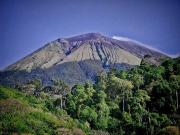Established in 2001, the Juan D. Nepomuceno Center for Kapampangan Studies aims to sustain interest in the study of Kapampangan language, history and culture. It is housed in a three-story structure in Holy Angel University and contains a gallery, a museum and a library. The center subscribes to the motto "Be a good Kapampangan to be a better Filipino."
History
The center is named after the late Don Juan D. Nepomuceno, a Pampango philanthropist and former mayor of Angeles City. It was formally endowed in 2001 after Holy Angel University hosted the first International Conference on Kapampangan Studies.
Management
The current director of the center is Robbie Tantingco. It has an in-house staff of five and employs consultants in the fields of history, political science and the arts to guide its programs and undertakings.
Publications
The center publishes SingSing, a quarterly magazine devoted to Kapampangan history and literature. The magazine takes its name from the famous Kapampangan folk song "Atin cu pung singsing," which tells of a precious gold ring lost and then found. The use of the word 'singsing' in the magazine is a metaphor for the loss and retrieval--through the center's efforts--of Kapampangan culture.
The center also publishes the annual Kapampangan Research Journal. Edited by Dr. Lino Dizon, the journal features articles written by scholars on Kapampangan language and history. Nine issues of the magazine have been released.
Old Kapampangan vocabularies and grammars are also periodically published by the center under the name of Holy Angel University.
Getting There
Don Juan D. Nepomuceno Building (DJDN) is located in the main building of Holy Angel University (HAU), Sto. Rosario, Angeles City
By bus: This is the most common and economical way to get to Angeles from Metro Manila. Several air-conditioned bus lines ply from Manila to Angeles route with terminals scattered across the metropolitan area. It normally takes one-and-a-half hours to get to Angeles by bus. However, travellers are well advised to consider the unpredictable effect heavy traffic and downpours will have on the commute. In short, give yourself plenty of time to travel by bus. Provincial bus companies have scheduled trips from Manila to the provinces to northern provinces and key cities.
By car: The best way from Manila to Angeles via car is taking the North Luzon Expressway which extends until Sta. Ines in Mabalacat, Pampanga. You may take either the Angeles Exit or Dau exit to get there. Another motorway, though narrow, is the McArthur Highway and visitors need to pass through the province of Bulacan to get to Angeles on both routes. It usually takes about 45 minutes to travel but it is twice the travel time if you plan to take the McArthur route due to heavy traffic along its stretch. Rental car companies can be found all over Manila and Angeles. If you don't know the routes, you can hire drivers by asking the attendant of the rent-a-car shop.
Getting around
By jeepney: To hop on a colorful jeepney (small bus) is certainly the most affordable way to get around downtown. It is available 24 hours a day and it is the most famous mode of transportation in the country, which connects towns and cities together. Since jeepneys tend to be overcrowded with passengers, tourists carrying bulky luggage should consider traveling by taxi.
By taxi: Though more convenient for tourists, taxis are less common in Angeles and not normally used for travel outside the city. Rather, they are primarily used to tour around the Clark Freeport Zone and for transport to and from the airport. Simson's taxicab terminal can be found particularly next to Clark's main gate (opposite Jollibee's) and SM City-Clark mall in Balibago.
By trike: Trikes (or tricycles) are motocycles with a small attached passenger cabin. They are restricted to low-speed roads and not permitted to enter the area surrounding the airport. Passengers of larger physical stature may find riding in them uncomfortable. Nevertheless, because of their slower speeds, trikes are generally a safe mode of transport.










